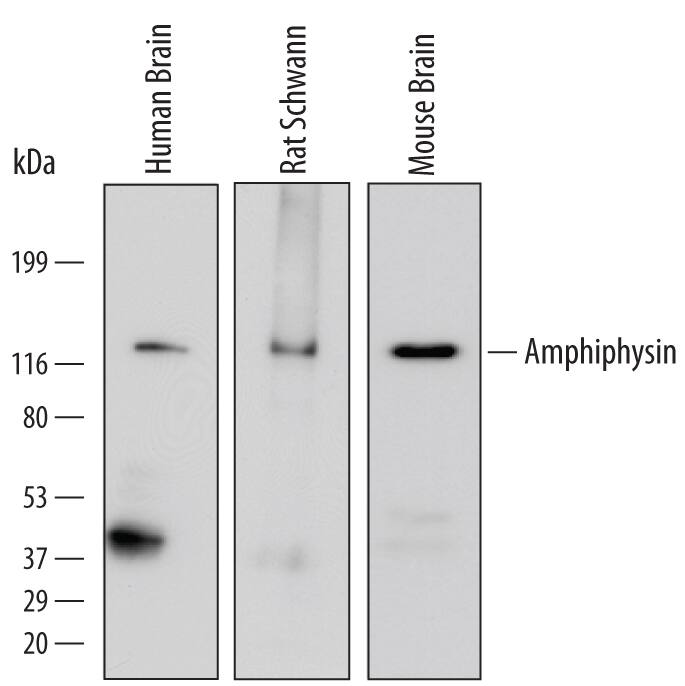Human/Mouse/Rat Amphiphysin/AMPH Antibody
R&D Systems, part of Bio-Techne | Catalog # AF6527

Key Product Details
Species Reactivity
Applications
Label
Antibody Source
Product Specifications
Immunogen
Asn204-Gly300
Accession # P49418
Specificity
Clonality
Host
Isotype
Scientific Data Images for Human/Mouse/Rat Amphiphysin/AMPH Antibody
Detection of Human, Mouse, and Rat Amphiphysin/AMPH by Western Blot.
Western blot shows lysates of human brain tissue, rat Schwann cells, and mouse brain tissue. PVDF Membrane was probed with 0.5 µg/mL of Human/Mouse/Rat Amphiphysin/AMPH Antigen Affinity-purified Polyclonal Antibody (Catalog # AF6527) followed by HRP-conjugated Anti-Goat IgG Secondary Antibody (Catalog # HAF109). A specific band was detected for Amphiphysin/AMPH at approximately 128 kDa (as indicated). This experiment was conducted under reducing conditions and using Immunoblot Buffer Group 1.Applications for Human/Mouse/Rat Amphiphysin/AMPH Antibody
Western Blot
Sample: Human brain tissue, rat Schwann cells, and mouse brain tissue
Formulation, Preparation, and Storage
Purification
Reconstitution
Formulation
Shipping
Stability & Storage
- 12 months from date of receipt, -20 to -70 °C as supplied.
- 1 month, 2 to 8 °C under sterile conditions after reconstitution.
- 6 months, -20 to -70 °C under sterile conditions after reconstitution.
Background: Amphiphysin/AMPH
AMPH (Amphiphysin; also AMPH1) is a 128 kDa member of the Amphiphysin family, BAR superfamily of proteins. Although its calculated MW is only 78 kDa, it runs anomalously in SDS-Page at 125-128 kDa. It is expressed in neurons, Sertoli cells, possibly in anterior pituitary endocrine cells and apparently cardiac muscle. It appears to form heterodimers with AMPH2, and in this configuration, promotes clathrin-associated endocytic vesicle formation. Furthermore, and perhaps related, AMPH also interacts with N-WASP, initiating actin polymerization. Human AMPH is 695 amino acids (aa) in length. It contains an N-terminal BAR domain (aa 24-240) that binds lipids, a central region that binds AP2 (aa 322-340) and clathrin (aa 347-386), and a C-terminal SH3 domain (aa 622-695) that binds proline-rich ligands. There is one known 108 kDa splice variant that shows a deletion of aa 425-466. Over aa 204-300, human AMPH shares 98% aa identity with mouse AMPH.
Alternate Names
Gene Symbol
UniProt
Additional Amphiphysin/AMPH Products
Product Documents for Human/Mouse/Rat Amphiphysin/AMPH Antibody
Product Specific Notices for Human/Mouse/Rat Amphiphysin/AMPH Antibody
For research use only
